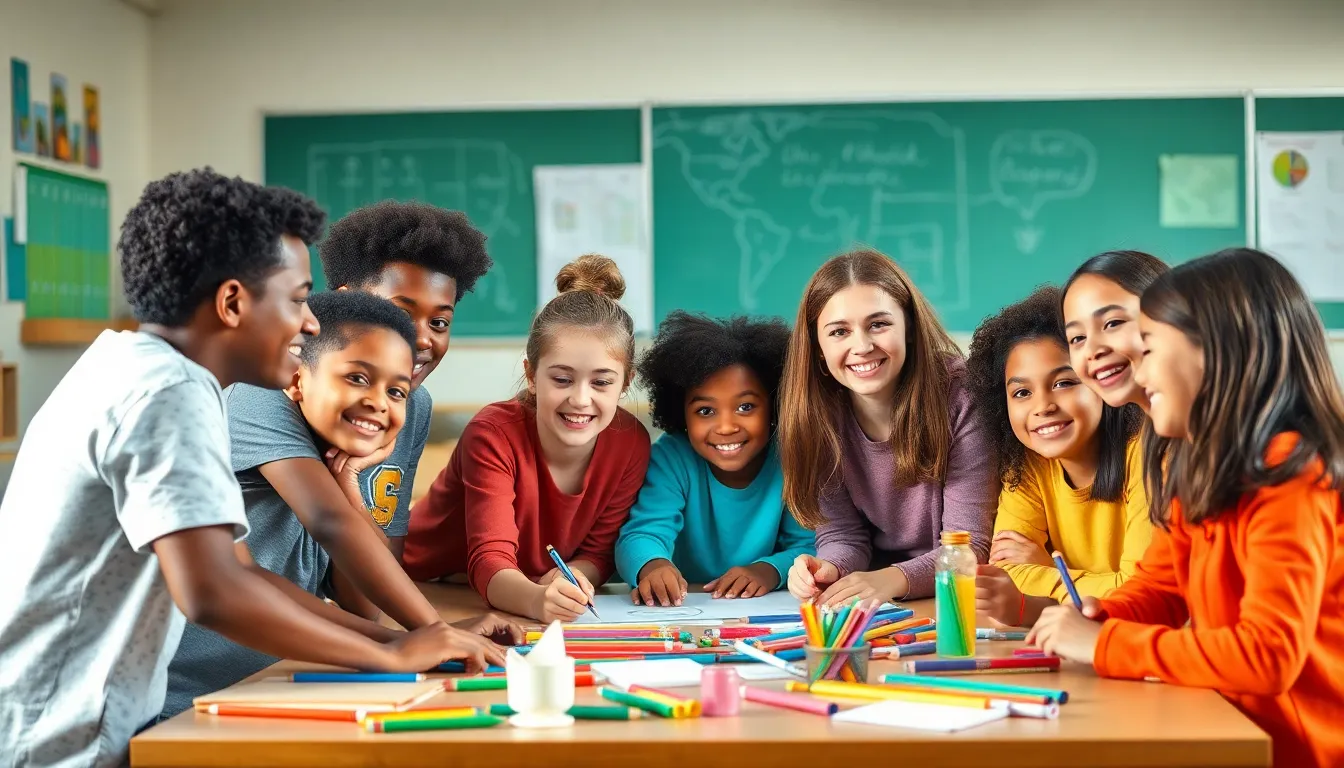Table of Contents
ToggleIn today’s diverse classrooms, multicultural education methods aren’t just a nice-to-have; they’re essential. Picture this: students from different backgrounds, each bringing unique perspectives, ideas, and snacks to the table. By embracing these differences, educators can transform the learning experience into an enriching adventure.
Imagine a world where cultural stories come alive, where history isn’t just a list of dates but a vibrant tapestry woven from various traditions. Multicultural education methods make this possible, fostering understanding and respect among students. It’s not just about teaching; it’s about creating a community where everyone feels valued and included.
Overview Of Multicultural Education Methods
Multicultural education methods address the diverse needs of students in classrooms. Inclusive strategies create opportunities for all learners to engage meaningfully with culturally relevant content. These methods often integrate diverse perspectives into the curriculum, enabling students to relate their own experiences to academic material.
Utilizing cooperative learning promotes collaboration among students from different backgrounds. This approach encourages dialogue and understanding, cultivating respect for varied viewpoints. Project-based learning serves as another effective technique, allowing students to explore real-world issues through a multicultural lens.
Curriculum that reflects multiple cultures enriches classroom discussions, fostering an environment of inclusivity. Educators play a critical role by incorporating texts, resources, and materials that showcase diverse authors and historical figures.
Culturally responsive teaching adapts instructional strategies to cater to students’ cultural contexts. This method enhances educational effectiveness by recognizing the importance of students’ backgrounds in their learning processes.
Assessment practices also need to reflect multicultural perspectives. Implementing varied assessment types, such as portfolios and presentations, gives all students equal opportunity to demonstrate their understanding.
Teacher professional development can enhance the effectiveness of multicultural education methods. Educators continually learn about cultural competencies and best practices for engaging diverse student populations.
Importance Of Multicultural Education

Multicultural education fosters a diverse and supportive learning environment. It emphasizes the importance of embracing various cultural perspectives to enhance the educational experience.
Social Justice And Equity
Social justice plays a vital role in multicultural education. It promotes equal opportunities for all students, regardless of their background. By incorporating varied voices into the curriculum, educators foster an environment where every student’s identity and experiences are acknowledged. These inclusive practices encourage empathy and understanding, leading to more equitable classrooms. When students learn about social justice, they develop a sense of responsibility to advocate for themselves and others. This advocacy cultivates critical thinking skills and engages students in meaningful discussions about equity and inclusion.
Cultural Responsiveness
Cultural responsiveness enhances educational effectiveness by adapting teaching methods to meet diverse student needs. By recognizing and valuing students’ cultural backgrounds, educators create an inclusive atmosphere that supports learning. Employing culturally relevant materials helps engage students and reflects their identities in the curriculum. This approach promotes respect and understanding among peers. Educators who practice cultural responsiveness are better equipped to address students’ unique learning styles. Continually reflecting on cultural contexts improves the overall educational experience, making it more impactful for all learners.
Common Multicultural Education Methods
Multicultural education methods enhance inclusivity and engagement in diverse classrooms. These approaches ensure that all students feel valued and heard.
Culturally Relevant Pedagogy
Culturally relevant pedagogy focuses on students’ cultural contexts to improve learning. Educators incorporate students’ cultural backgrounds into lessons, fostering relatability. This method emphasizes not just academic success but also social competence. By connecting curriculum content to students’ experiences, it nurtures a sense of belonging. Teachers often use diverse texts that resonate with various student groups, promoting empathy and understanding.
Collaborative Learning
Collaborative learning encourages students to work together across cultural lines. It fosters dialogue and respect among peers, allowing for shared insights. Group projects enable learners to combine unique perspectives, enriching discussions. This method enhances critical thinking and teamwork skills, essential for real-world interactions. Relationships form as students engage in cooperative tasks, breaking down barriers and building trust.
Inclusive Curriculum
An inclusive curriculum reflects the diverse cultures present in the classroom. This approach integrates varied cultural perspectives across subjects, making learning relevant for all. By including materials from multiple cultures, educators stimulate curiosity and respect. Lessons designed with inclusivity in mind create a sense of identity among students. Adjustments to traditional content offer diverse narratives that resonate with every learner, ensuring equitable opportunities for all.
Challenges In Implementing Multicultural Education
Implementing multicultural education presents specific challenges that can hinder progress in diverse classrooms.
Institutional Barriers
Institutional barriers often obstruct the adoption of multicultural education methods. Policies may lack inclusivity or fail to recognize the value of diverse perspectives, limiting curriculum flexibility. Insufficient funding restricts resource allocation for culturally diverse materials and training programs. Additionally, administrative support might be minimal, which can diminish enthusiasm for these initiatives among educators. Educators may encounter resistance from colleagues, particularly if there’s a lack of foundational knowledge regarding multicultural practices. As systems struggle to adapt, the overall effectiveness of multicultural education diminishes in the classroom.
Teacher Preparedness
Teacher preparedness significantly impacts the success of multicultural education. Many educators lack adequate training in culturally responsive teaching strategies, which is essential for addressing diverse student needs. Inexperience with integrating multicultural content into existing curricula can lead to superficial implementation. Professional development opportunities may be limited, preventing teachers from acquiring necessary skills. Furthermore, teachers’ confidence in managing discussions about sensitive cultural topics often varies, leading to inconsistencies in classroom engagement. As a result, the effectiveness of multicultural education relies heavily on the professional growth and readiness of educators.
Embracing multicultural education methods is essential for fostering an inclusive and respectful learning environment. By integrating diverse perspectives into the curriculum and employing culturally responsive teaching strategies, educators can better meet the needs of all students. This approach not only enriches classroom discussions but also cultivates empathy and critical thinking skills.
Despite the challenges in implementation, the commitment to professional development and resource allocation can significantly enhance the effectiveness of these methods. As educators continue to adapt and grow, they play a pivotal role in shaping a more equitable educational landscape. Ultimately, prioritizing multicultural education creates opportunities for every student to thrive and feel valued in their learning journey.








